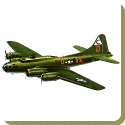 B-17 Flying Fortress — The U.S. World War II B-17F Flying Fortress, about 21 m (70 ft) long, flew at 510 km/h (317 mph) and could carry a 2,720-kg (6,000-lb) bombload.
B-17 Flying Fortress — The U.S. World War II B-17F Flying Fortress, about 21 m (70 ft) long, flew at 510 km/h (317 mph) and could carry a 2,720-kg (6,000-lb) bombload.
History
The Boeing B-17 Flying Fortress is an American four-engine heavy bomber aircraft developed for the US Army Air Corps (USAAC). Competing against Douglas and Martin for a contract to build 200 planes, the Boeing entry outperformed both the other competitors and more than met the Air Corps’ expectations. Although Boeing lost the contract due to the prototype’s crash, the Air Corps was so impressed with Boeing’s design that they ordered 13 B-17s. The B-17 Flying Fortress went on to enter full-scale production and was considered the first truly mass-produced large aircraft, eventually evolving through numerous design advancements, from B-17A to G.
The B-17 was primarily employed in the daylight precision strategic bombing campaign of World War II against German industrial and civilian targets (such as Dresden). The United States Eighth Air Force based in England and the Fifteenth Air Force based in Italy complemented the RAF Bomber Command’s nighttime area bombing in Operation Pointblank, to help secure air superiority over the cities, factories and battlefields of Western Europe in preparation for Operation Overlord. The B-17 also participated, to a lesser extent, in the War in the Pacific.
From its pre-war inception, the USAAC touted the aircraft as a strategic weapon; it was a potent, high-flying, long-ranging bomber capable of unleashing great destruction yet able to defend itself. With the ability to return home despite extensive battle damage, its durability, especially in belly-landings and ditchings, quickly took on mythic proportions. Stories and photos of B-17s surviving battle damage widely circulated, boosting its iconic status. Despite an inferior range and bombload compared to the more numerous B-24 Liberator, a survey of Eighth Air Force crews showed a much higher rate of satisfaction in the B-17. With a service ceiling greater than any of its Allied contemporaries, the B-17 established itself as a superb weapons system, dropping more bombs than any other US aircraft in World War II. Of the 1.5 million tonnes of bombs dropped on Germany, 500,000 were dropped from B-17s.
 Kids Portal For Parents India Kids Network
Kids Portal For Parents India Kids Network
